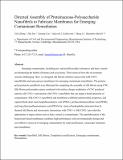Directed Assembly of Proteinaceous–Polysaccharide Nanofibrils to Fabricate Membranes for Emerging Contaminant Remediation
Author(s)
Zhang, Yilin; Sun, Hui; Cao, Yunteng; Kalinowski, Maxwell J.; Li, Meng; Marelli, Benedetto; ... Show more Show less
DownloadZhang_et_al_ACS_Nano_10.1021_acsnano.4c07409.pdf (1.366Mb)
Open Access Policy
Open Access Policy
Creative Commons Attribution-Noncommercial-Share Alike
Terms of use
Metadata
Show full item recordAbstract
Emerging contaminants, including per- and polyfluoroalkyl substances and heavy metals, are threatening the health of humans and ecosystems. Their removal from the environment remains challenging. Here, we designed silk fibroin–cellulose nanocrystal (silk-CNC) nanofibrillar and nanoporous membranes for emerging contaminant remediation. The protein–polysaccharide nanofibrils were fabricated by templating the assembly of silk fibroin using CNCs. Silk fibroin polymorphic nature combined with surface charge modulation of CNCs produced cationic silk-CNC(+) and anionic silk-CNC(−) nanofibrils that can target a broad spectrum of contaminants. Silk-CNC(+) nanofibrils and membranes exhibited antimicrobial properties and captured both short-chain heptafluorobutyric acid, perfluorobutanesulfonic acid, and long-chain perfluorooctanoic acid by virtue of hydrophobic attraction from β-sheeted silk fibroin and electrostatic interactions with CNC(+). Silk-CNC(−) provided the opportunity to target cations such as heavy metal cocontaminants. The nanofabrication of biopolymer-based membranes combines high performance with environmentally benign and cost-effective removal of emerging contaminants for water purification, wastewater treatment, and remediation.
Date issued
2024-08-27Department
Massachusetts Institute of Technology. Department of Civil and Environmental EngineeringJournal
ACS Nano
Publisher
American Chemical Society
Citation
Yilin Zhang, Hui Sun, Yunteng Cao, Maxwell J. Kalinowski, Meng Li, and Benedetto Marelli
ACS Nano.
Version: Author's final manuscript
ISSN
1936-0851
1936-086X